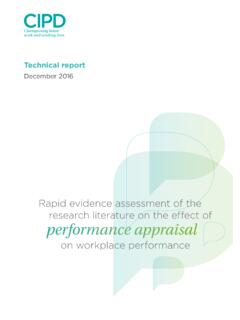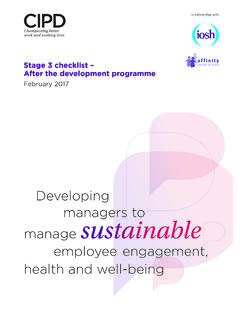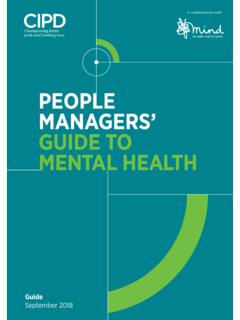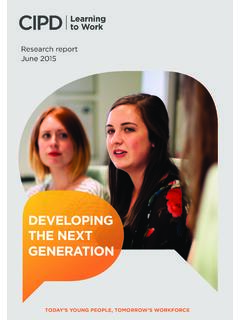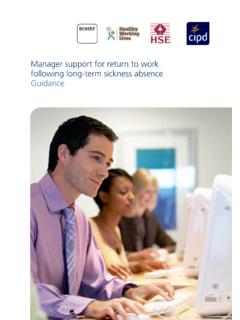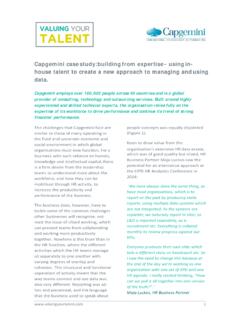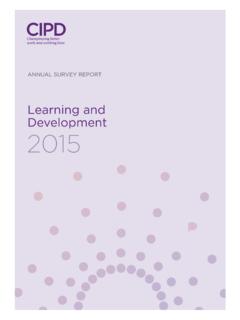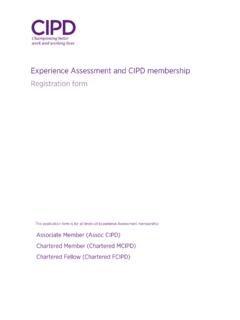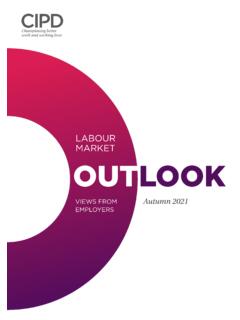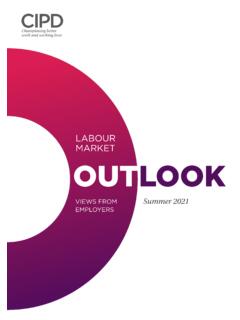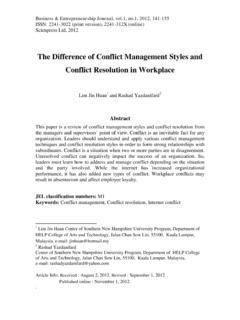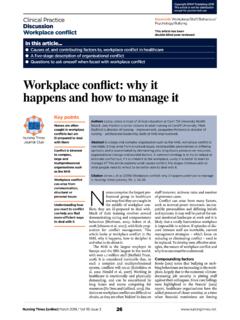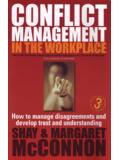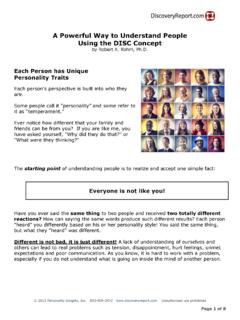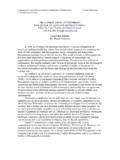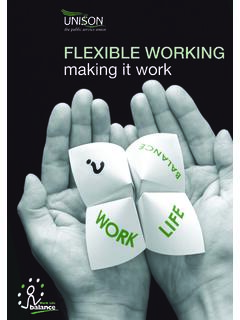Transcription of REPORT January 2020 Managing conflict in the modern …
1 Managing conflict in the modern workplaceREPORT | January 2020 The CIPD is the professional body for HR and people development. The not-for-profit organisation champions better work and working lives and has been setting the benchmark for excellence in people and organisation development for more than 100 years. It has more than 150,000 members across the world, provides thought leadership through independent research on the world of work, and offers professional training and accreditation for those working in HR and learning and conflict in the modern workplace1 AcknowledgementsThis REPORT was written by Rachel Suff at the CIPD. The CIPD would like to thank YouGov for conducting the surveys and focus groups. We would also like to thank those who provided input to the survey questions, including Jonny Gifford, Claire McCartney and Dr Jill Miller and other colleagues at the CIPD.
2 We would particularly like to thank Richard Saundry, Professor of HRM and Employment Relations at the University of Sheffield and Caroline Sheridan, CEO Sheridan Resolutions Ltd and Chair and Board Director of the CMC workplace and Employment Group, for their input on the survey conflict in the modern workplaceContents Introduction 2 What do the findings mean for people professionals? 4 What s the climate like in UK workplaces? 8 The extent and nature of workplace conflict 11 Bullying and harassment at work: who, what, where? 17 Sexual harassment: pushed under the carpet? 23 Speaking up at work how easy and effective is it? 27 How do organisations deal with conflict ?
3 33 How well do managers manage conflict ? 37 Encouraging early, informal ways to resolve conflict 40 Background to the research 41 Notes/additional reading 43 Managing conflict in the modern workplace231 IntroductionMost of us spend a large portion of our waking hours at work, and so the quality of the working environment has a significant impact on our well-being. Relationships in the workplace affect the culture as well as the overall quality of work. This is why collective and social relationships forms a key domain in the CIPD s well-being model and why Relationships at work is one of the seven dimensions of the CIPD s Job Quality Index for good , 2 A supportive working environment and positive relationships can greatly enhance our experience of work; conflict can seriously undermine it.
4 Negative conflict at work also seriously undermines people s performance and productivity. It is stressful and time-consuming for all concerned, and takes focus away from delivering on objectives and organisational conflict can occur across a wide spectrum of behaviour, from a low-level difference of opinion to serious incidents of bullying or harassment. Movements like #MeToo have shone a sharp spotlight on the stubborn incidence of sexual harassment in the workplace , despite decades of equalities legislation. Against this backdrop of hopefully heightened awareness about unfair treatment at work, this REPORT examines the state of working relationships in UK organisations. It draws on the views and experiences of both employers and employees, gathered from surveys and employee focus groups, to give us a rounded picture of the employment relationship.
5 The REPORT s findings provide insight into pressing workplace issues such as the quality of working relationships, the incidence of conflict , how confident people are to speak up about bullying and harassment, and how effectively organisations and managers handle complaints. Not all conflict is necessarily negative, but even a minor disagreement between people can fester and escalate if it s not addressed and resolved at the earliest opportunity. Our research shows that conflict is very much a part of organisational life, and a common occurrence at work according to a significant proportion of both employees (26%) and employers (20%). Our survey of employees found that just over a third (35%) had experienced some form of interpersonal conflict , either an isolated dispute or ongoing difficult relationship, over the past year.
6 Employees are almost twice as likely to have experienced bullying than harassment (not sexual harassment) at work over the past three years (15% versus 8%). Just 4% REPORT experience of sexual findings draw attention to the serious problem of bullying and harassment in UK workplaces and the devastating impact unfair treatment can have on individuals and organisations. They reveal a continued reliance on formal processes and procedures to deal with conflict and evidence of a serious perception reality gap. Employers and people managers confidence to deal with conflict is not matched by the experience of employees who have been on the receiving end of it. We find a good level of confidence shown by employers and employees around people s ability to speak up at work but a less-than-satisfactory resolution rate: under half of employees (44%) experiencing conflict REPORT that the conflict or difficult relationship has so far been fully or largely resolved.
7 And the individual s people manager is just as likely to have made the situation worse as helped to resolve the conflict in the modern workplace3 IntroductionIt can take a lot of courage for someone to speak up about inappropriate behaviour at work, but there are very mixed and disappointing results on the ability of organisations to deal compassionately and effectively with complaints. Many people felt their organisation didn t act swiftly or fairly to resolve the complaint, or that they were even being blamed for the situation. This REPORT highlights key challenges for people professionals in how they guide organisations in handling conflict at work. It s encouraging that employees show a willingness to speak up if they feel they are being unfairly treated at work, but if the organisation s response falls far short of what s needed, people s confidence could be short-lived.
8 Much more focus is needed by organisations to create genuinely inclusive cultures that recognise and nip conflict in the bud, respond quickly and sensitively to complaints, and ensure people managers are part of the solution and not the problem. For more information on fostering an inclusive workplace , see our research on building inclusive 1: What is conflict ?We all have different experiences, backgrounds and perspectives which mean that we often see the world in different ways. This means we can all react differently to situations at work, which can also affect the relationships we have. This diversity of experience and thought is a good thing, but on occasion it can also lead to misunderstanding and conflict between individuals which need effective resolution strategies.
9 It s hard to pin down a precise definition of conflict , and one person s perception of a difficult situation can differ from someone else s. Some conflict can even be positive, such as a healthy amount of competition to reach goals or when a problem-solving approach is used to discuss differing opinions on a work project to reach a creative solution. A work group may have a conflict in deciding what strategy to pursue, or how to allocate responsibilities, for example. These conflicts can have a fruitful outcome if managed can be a fine line between this kind of conflict and where conflict becomes negative, such as behaviour that is unfair and unethical, and causes distress and disruption to the individual, group and even the wider organisation. Negative conflict between individuals at work can occur across a wide spectrum of behaviour, ranging from a one-off disagreement, or personality clash or ongoing difficult relationship, to more serious manifestations of unfair treatment such as bullying and harassment.
10 Unhealthy conflict that has a negative impact on people can come in overt forms, such as verbal abuse or a shouting match. But it can also come in less tangible and visible forms, such as underlying and destructive tensions or resentment between people or isolating someone from a social event. It s this latter type of conflict that in some ways can be more challenging for organisations to identify and tackle. This is why organisations need to understand the myriad ways in which conflict can occur between individuals and be alert to any undercurrents in the working culture. The key to successful conflict management is understanding the real reasons for it, which in turn should ensure the organisation has an appropriate response to resolving it. Managing conflict in the modern workplace45 What do the findings mean for people professionals?
